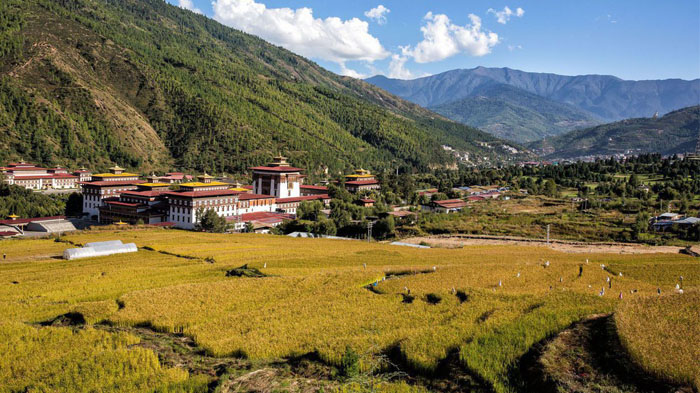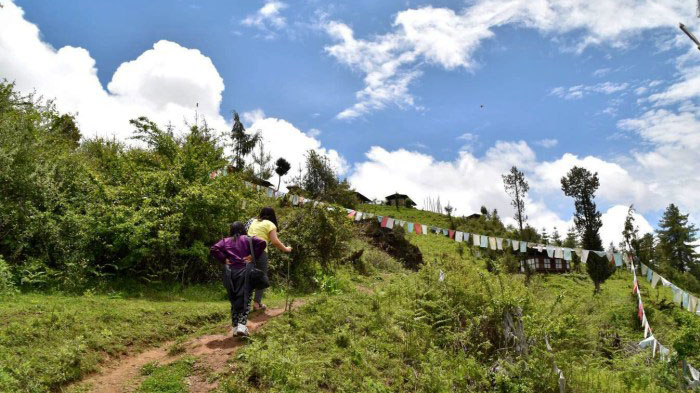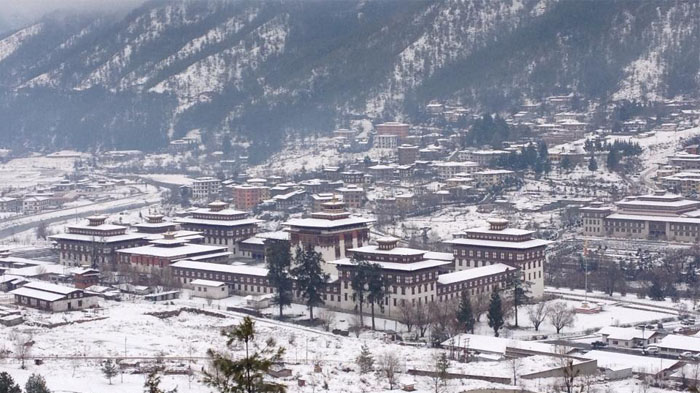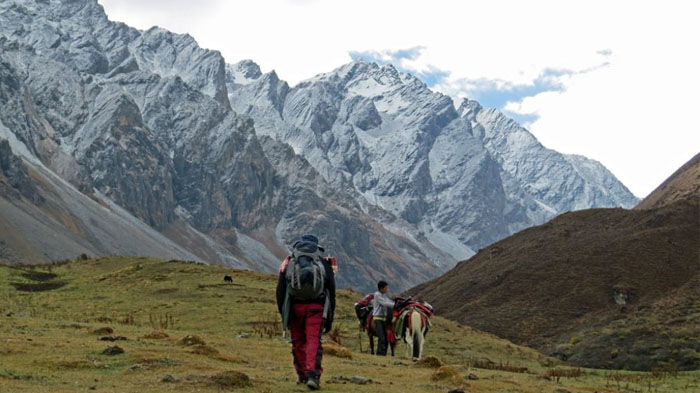
Weather and climate of Thimphu
Located in the northwest of Bhutan, Thimphu, the kingdom’s capital, lies in one of the colder regions of the country, in an area where winters can be bearably harsh but summers are not as wet as in most of the rest of Bhutan. Overall, the weather in Bhutan is warmer in the east than in the west, and in the south, is more of a tropical climate than an alpine climate. In the northern parts of the kingdom, the mountains rise up to over 7,000 meters above sea level, and the weather can be extremely cold, with heavy snow on the mountains.
Bhutan has a varying altitude from north to south, with the higher areas averaging around 5,000+ meters, dropping to just a few hundred meters above sea level in the southern border areas near India. Winters are the best time to visit the lower areas, while spring and autumn are best for trekking and visiting the central and northern areas. Thimphu, which is in the northwest, has an alpine mountain climate, with cold winters and warm summers, and with less rain in the monsoon season than in the east and south.
What is Thimphu weather and climate by month?
Thimphu Weather Guide
 Table of Thimphu Weather Guide
Table of Thimphu Weather Guide
Spring (March - May)
Average daytime temperature: 17°C
Average nighttime temperature: 7°C
Average wind speed: 13km/h
Average precipitation/month: 57mm
Clear days/month: 21
March is the start of spring in Thimphu, and among the most popular times to visit the Bhutanese capital. The landscape is draped in new wildflowers and the snows are slowly melting, giving way to greener scenery and that feeling of spring in the air. Temperatures through the month average around 10 degrees, with daily highs of up to 17 degrees and nightly lows of around 4 degrees. There is less rainfall, with an average of around 23mm throughout the month. - Check the detailed weather statistic and find out your favorable time to visit Bhutan.
 The famous Tashicho Dzong in Spring shows its charm to travelers.
The famous Tashicho Dzong in Spring shows its charm to travelers.
April is the middle of spring in Thimphu, and the weather is definitely getting warmer, with the vegetation becoming lush and greenas the main trekking season begins. Average temperatures in Thimphu are around 13.6 degrees, with highs of around 20 degrees in the daytime and lows of only 7-8 degrees at night. You can also expect more rainfall, with around 58mm through the month.
May sees an increase in the humidity levels in the northwest of Bhutan, as the spring begins to give way to summer, and temperatures average around 17-18 degrees. There is a much higher chance of rainfall, and tourism drops off as the wet season takes its hold. Daytime highs of 23 degrees drop to around 13 degrees at night, and the month sees around 122mm of rainfall.
Summer (June - August)
Average daytime temperature: 23.5°C
Average nighttime temperature: 14°C
Average wind speed: 13km/h
Average precipitation/month: 120mm
Clear days/month: 20
June is the start of summer in Thimphu, and sees the arrival of the monsoon season, though the wet weather is not as bad as in the south. Showers normally occur in the late afternoons and evenings, so sightseeing is still possible. Temperatures average around 20 degrees, with highs of around 24-25 degrees and lows of around 15 degrees. June sees around 198mm of rain.
 The beautiful scenery and blue sky of Thimphu in Summer.
The beautiful scenery and blue sky of Thimphu in Summer.
July is the wettest month of the year, when the Bhutanese capital region sees around 373mm of rainfall throughout the month. Summer is well under way, and the Indian monsoon even affects the northwest areas of Paro and Thimphu, bringing wetter humid weather and low-hanging clouds. Temperatures average around 16 degrees, with highs of 19 degrees in the daytime and nightly lows of just 13 degrees.
August is the second wettest month of the year, with monsoon rains still affecting the Bhutanese capital area. On average, the capital sees around 345mm of rainfall, as the Indian monsoon gently weakens. Temperatures range from 25 degrees in the daytime to around 15 degrees at night, with an average of around 20 degrees throughout the month.
Autumn (September - November)
Average daytime temperature: 23.5°C
Average nighttime temperature: 14°C
Average wind speed: 15km/h
Average precipitation/month: 42mm
Clear days/month: 20
September in Thimphu sees the end of the rainy season and the start of the drier weather, and the hot sticky temperatures become more comfortable for the incoming tourists. While there may still be the odd shower, rainfall is down to around 155mm throughout the month, with temperatures ranging from 19 degrees in the daytime to round 15 degrees at night, making it more pleasant.
 Trekking in the mountain region in Autumn. What an excellent experience.
Trekking in the mountain region in Autumn. What an excellent experience.
October is one of the most popular months of the year to visit Thimphu, and the visibility of the mountains is sparklingly clear. The weather is still warm and sunny, with highs of around 22 degrees, though the nightly temperatures are now dropping, averaging just 10 degrees. Rainfall is also reduced to around 38mm for the entire month.
November is the middle of the peak season in Thimphu, with plenty of great views of the mountains and an ideal time to trekking in the kingdom. The dry weather is much more pleasant and the autumn air is clean and crisp. Temperatures range from around 17 degrees in the daytime to as low as 5 degrees at night, and the area has only around 8mm of rainfall throughout the whole month.
Winter (December - February)
Average daytime temperature: 10°C
Average nighttime temperature: 2°C
Average wind speed: 19km/h
Average precipitation/month: 21mm
Clear days/month: 26
December is the start of the colder months in the area of the Bhutanese capital, though it is still warmer in the valley of the city than in the hills above. Snowfall is more likely to the north, and the icy winds of the northeast monsoon can make it feel a little colder. Temperatures range from around 14 degrees in the day to as low as -1 degrees at night and very little chance of rain.
 Rarely seen fluffy snow falling from the sky of Thimphu in chilly winter
Rarely seen fluffy snow falling from the sky of Thimphu in chilly winter
January may be the coldest month of the year, but it is one of the most popular times to visit Thimphu outside of the main tourist seasons because of the stunning Himalayan scenery and the bright clear days. Much of the country is still cold and frosty, and parts of Thimphu can be snowbound with temperatures averaging around 5 degrees throughout the month. Highs of 12-13 degrees are normal during the sunny days, but at night the temperatures drop to around -3 degrees, and there is a slight chance of rain.
Winter is still very much entrenched in Thimphu in February, but there are subtle signs that spring is on the way. The weather is starting to get a little warmer, and some of the snow is beginning to recede, with less snowfall than in January. Average temperatures through the month are usually around 6 degrees, with daytime highs of around 14-15 degrees, and colder nights where temperatures drop to around freezing or 1 degree Celsius. There is a higher chance of rain, with around 44mm on average through the month.
When is the best time to visit Thimphu?
Thimphu is one of the few places in Bhutan that can be visited almost any time of the year. Temperatures in the daytime are not as cold as you might expect for a Himalayan country, and around the area of the capital are comparable with any north European country in the winter months, though with much more sunshine. Even in the summer, the monsoon rains do little to dampen spirits when traveling through the capital, and have very little effect on enjoyment of the city and its surroundings.
Spring in Thimphu, which runs from March to May, is often considered to be one of the most beautiful times of year, with an amazing array of colors across the area as the forests and meadows recover from the winter months and bring forth a rich abundance of flowers. The weather is warming up as the spring progresses, with bright sunny days and very little rain.
 September to November is the best time to visit Thimphu, Bhutan.
September to November is the best time to visit Thimphu, Bhutan.
Autumn, from September to November, is another beautiful time of year, when the skies are crisp and clear, with few clouds and some of the best views of the high mountains than at any other time of year. The climate is cooling down from the summer, yet temperatures are still warm. Autumn is also the time when leaves on the trees turn brown and start to drop, and the somber monasteries and Dzongs are at their most stunning.
Summer is the monsoon season in Thimphu and runs from June to the end of August. The Bhutanese capital receives most of its rain in these few months, though it is not the wettest place in western and central Bhutan in the summer months. However, Thimphu is not wet all the time, and the capital is a great place to visit, with less rain than in the south and rainfall that comes usually in the late evenings. Summer is the hottest time of year, as well, and humidity is off the scale, with highs of around 22 degrees in the warmest months of summer.
Winter, which runs from December to February, is the coldest time of year across the entire country, and in Thimphu, the winter temperatures can reach as low as -3 degrees at night. However, the weather is sunny, if a little cool, throughout the winter, and can be very agreeable. Much of the highway that runs to the east of Bhutan is often closed in the depths of winter, so it is the ideal time to visit the capital region of Bhutan, where the winter treks are some of the best in the world at this time of year.
Join-in Most Popular Thimphu Bhutan Tours
Is Thimphu weather in July and August too rainy or December and January too cold to visit?
What is the monsoon season like from late June to mid-September in Thimphu?
The monsoon season in Bhutan is heavier than anywhere else in the Himalayas, but in Thimphu, it is slightly less than in the lower regions of the kingdom. With rainfall ranging from 250-370mm throughout the three months of the summer, it can get a little wet, and the temperatures are higher which makes it very humid. However, the rainfall is still restricted to mostly falling in the late afternoon and evenings, so it does leave the daytimes mostly sunny for sightseeing, though you will not be able to go trekking in the mountains. There is the possibility of heavy rain throughout the day, though, in some instances, which can make the stay a little unpleasant.
Is it possible to visit Thimphu during the monsoon season?
Yes, it is possible to visit Thimphu in the monsoon season from June to August, as the rains are often only in the late afternoons and into the nights. Temperatures can be hot, which makes for higher humidity, but rarely get above 25 degrees, even in the hottest time of the year, so it is not as uncomfortable as you might think.
What is the winter like from December to February in Thimphu?
Winter in Thimphu can be very cold, with low temperatures of between 1 and -3 degrees. However, the daytimes can be warmer, with bright sunshine, that makes the temperatures feel more pleasant. Skies are also much clearer in the winter than at any other time of year, which makes the views of the high Himalayan Mountains some of the best you can find. Capped by the perpetual winter snows, these lofty peaks make a great sight and an even greater photo, and the 12-14 degrees temperatures make for comfortable days out.
Besides the city tour what else we can do in Thimphu winter?
While you may not be able to go trekking in the high mountains of the Himalayas to the north, there are treks in the area of the Thimphu Valley that can be done even in the winter months. The Sinchula Trek is a winter trek that follows the traditional ancient trails used by the local people for hundreds of years between Thimphu and Punakha. One of the most beautiful winter trails in Bhutan, this unique trek takes you through a landscape of blue pines, oak and rhododendron forests, and sun-soaked terraces of rice paddies, set beneath the vista of snow-capped mountains.
 Enjoying snow-capped mountains in the distance along the Sinchula trek route.
Enjoying snow-capped mountains in the distance along the Sinchula trek route.
Insider tips:
If you fancy a trek near Thimphu in winter, the following two trekking routes with their starting places not far from Thimphu are not recommended to challenge during the winter
1. For the Snowman trek, winter is not an appropriate time for most of the locals and trek lovers to challenge, for trudging off through the whirling snow in some high altitude areas is as dangerous as you choose winter to climb up the Mt. Everest, for some snowbound trials may lead you to untouched areas with no backups but all uncertainties.
2. It is also not wise to plan a Jomolhari (Laya Gasa) Trek in winter due to the high altitude and steep ascents and descents along the higher parts of the route trails.
3. Click here to find detailed information about Trekking in Bhutan.
Conclusion
Thimphu is definitely one of the places in Bhutan that can be visited throughout the year, and while there are wet and cold times of year, they are not so cold or wet as to spoil a holiday completely. Summers are filled with monsoons that fall late in the day, leaving plenty of sunny periods for sightseeing, and even the trekking can be done in the winter, though not at the higher altitudes. Overall, Bhutan and the capital, Thimphu, are the ideal year round destination for adventurous and discerning tourists in Asia.

Kham Sang is responsible and honest with more than six years of guide experience in Tibet.She has strong interpersonal skills and can communicate effectively with tourists.


.jpg)



0 Comment ON "Weather and climate of Thimphu"